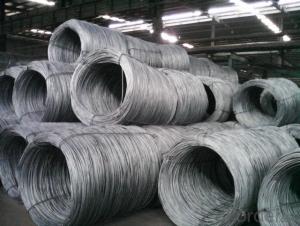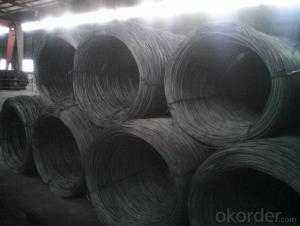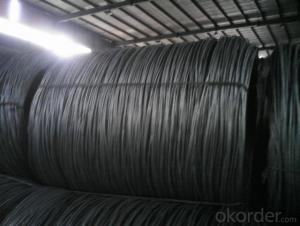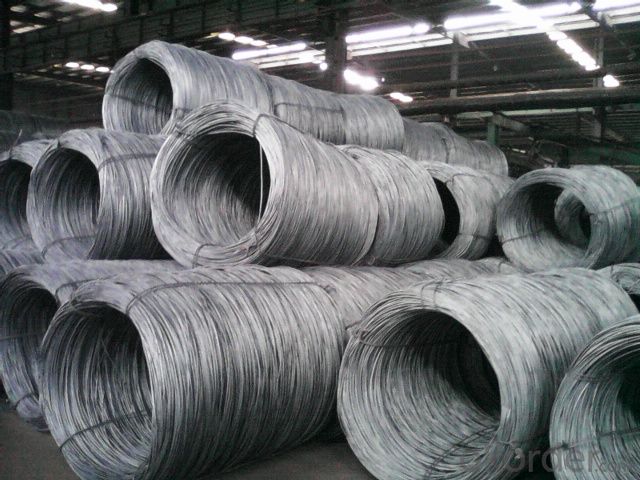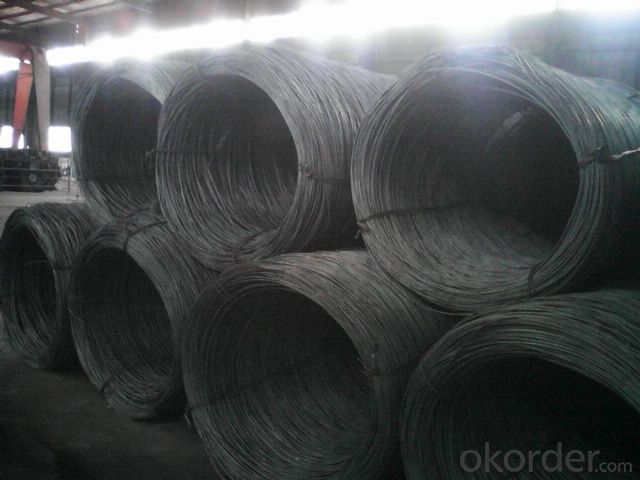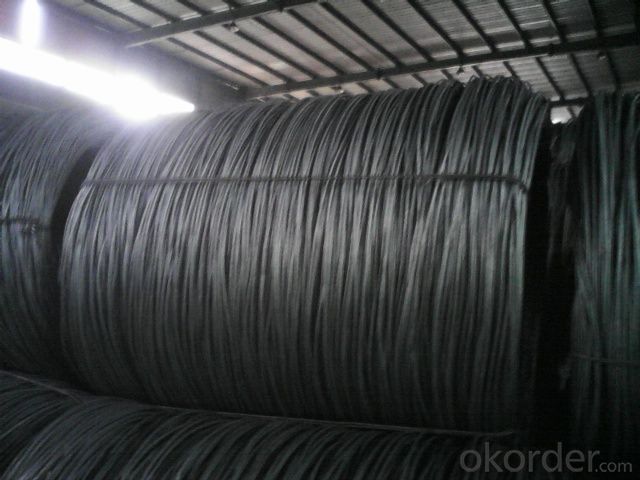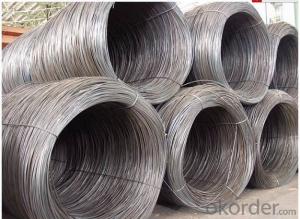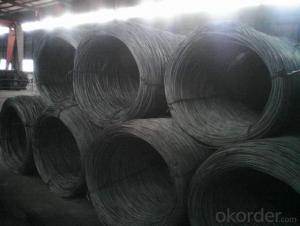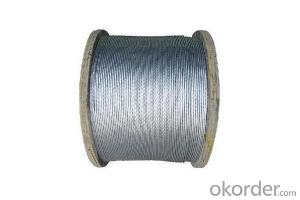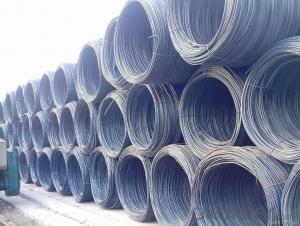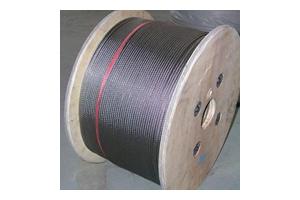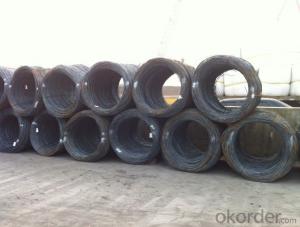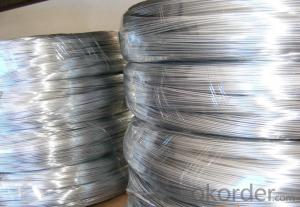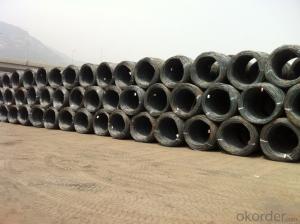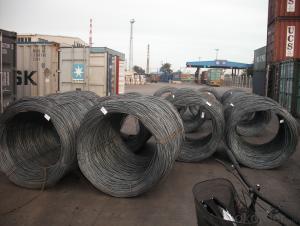Steel Wire Rod Stainless with High Qaulity and Competitive Prices
- Loading Port:
- Tianjin
- Payment Terms:
- TT or LC
- Min Order Qty:
- 20 m.t.
- Supply Capability:
- 10000 m.t./month
OKorder Service Pledge
OKorder Financial Service
You Might Also Like
Product Description:
OKorder is offering Steel Wire Rod Stainless with High Qaulity and Competitive Prices with worldwide shipping. Our supplier is a world-class manufacturer of steel, with our products utilized the world over. OKorder annually supplies products to European, North American and Asian markets. We provide quotations within 24 hours of receiving an inquiry and guarantee competitive prices.
Product Applications:
Steel Wire Rod Stainless with High Qaulity and Competitive Prices are ideal for structural applications and are widely used in the construction of buildings and bridges, and the manufacturing, petrochemical, and transportation industries.
Product Advantages:
OKorder's Steel Wire Rod Stainless with High Qaulity and Competitive Prices are durable, strong, and resist corrosion.
Main Product Features:
· Premium quality
· Prompt delivery & seaworthy packing (30 days after receiving deposit)
· Corrosion resistance
· Can be recycled and reused
· Mill test certification
· Professional Service
· Competitive pricing
Packaging & Delivery:
Packaging Detail: products are packed in bundle and then shipped by container or bulk vessel, deformed bar is usually naked strapping delivery, when storing, please pay attention to moisture proof. The performance of rust will produce adverse effect.
Each bundle weight: 2-3MT, or as required
Payment term: TT or L/C
Delivery Detail: within 45 days after received advanced payment or LC.
Label: to be specified by customer, generally, each bundle has 1-2 labels
Trade terms: FOB, CFR, CIF
FAQ:
Q1: Why buy Materials & Equipment from OKorder.com?
A1: All products offered byOKorder.com are carefully selected from China's most reliable manufacturing enterprises. Through its ISO certifications, OKorder.com adheres to the highest standards and a commitment to supply chain safety and customer satisfaction.
Q2: How do we guarantee the quality of our products?
A2: We have established an advanced quality management system which conducts strict quality tests at every step, from raw materials to the final product. At the same time, we provide extensive follow-up service assurances as required.
Q3: How soon can we receive the product after purchase?
A3: Within three days of placing an order, we will begin production. The specific shipping date is dependent upon international and government factors, but is typically 7 to 10 workdays.
Images:
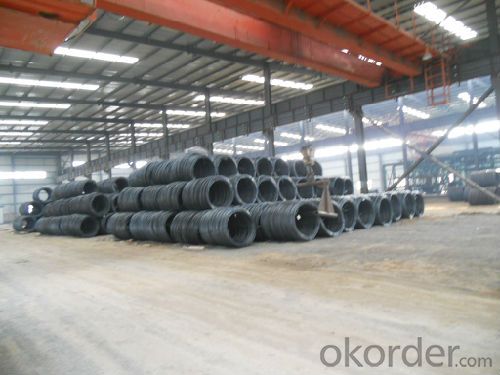
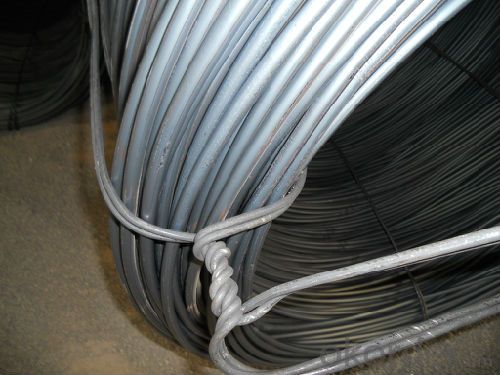
- Q: How does the magnetic properties of steel wire rod vary with different grades?
- The magnetic properties of steel wire rod vary with different grades due to the varying composition and microstructure of the steel. High carbon steel wire rods, for example, have a lower magnetic permeability and are less magnetic compared to low carbon steel wire rods. Additionally, the presence of alloying elements such as nickel or chromium can affect the magnetic properties. In general, the higher the carbon content and the more alloying elements present, the lower the magnetic properties of the steel wire rod.
- Q: What are the different types of steel wire rod available?
- There are several different types of steel wire rod available, including low carbon steel wire rod, high carbon steel wire rod, alloy steel wire rod, and stainless steel wire rod. Each type has its own unique properties and is used in various applications such as construction, automotive, manufacturing, and electrical industries.
- Q: How is steel wire rod stored in a warehouse or distribution center?
- To ensure convenient access, safety, and damage prevention, steel wire rod is typically stored in a warehouse or distribution center in a well-ordered manner. It is common practice to store the wire rod in long, cylindrical bundles or coils, the size and weight of which vary based on specific requirements. In order to store the steel wire rod, the warehouse or distribution center employs a combination of racks, shelves, or specially designed storage systems. These storage systems are tailored to accommodate the weight and dimensions of the wire rod bundles or coils, ensuring stability and mitigating potential hazards. In certain instances, wire rods are stacked vertically on racks or shelves, with each bundle or coil placed on top of the other. This vertical storage method optimizes space utilization and facilitates the identification of different types or sizes of wire rod. Alternatively, wire rod may also be stored horizontally on racks or shelves. This approach is frequently employed when the wire rods are too heavy or lengthy to be stored vertically. Horizontal storage facilitates easier handling and guards against deformation or damage to the wire rod. Regardless of the chosen storage method, it is imperative to maintain a dry and well-ventilated environment to prevent corrosion of the steel wire rod. Additionally, proper labeling and documentation play a crucial role in efficiently identifying and tracking the wire rod inventory. Overall, the storage of steel wire rod in a warehouse or distribution center necessitates meticulous planning and organization to ensure efficiency, safety, and the preservation of the wire rod's quality.
- Q: How is steel wire rod used in the manufacturing of wire mesh sieves?
- Steel wire rod is used in the manufacturing of wire mesh sieves as it serves as the raw material for creating the wire mesh. The wire rod is drawn down to the desired diameter and then woven or welded together to create the mesh pattern. This allows for the production of sturdy and durable sieves that can effectively separate particles and materials in various industries such as mining, construction, and agriculture.
- Q: What are the common mechanical properties of steel wire rod?
- The common mechanical properties of steel wire rod include high tensile strength, good ductility, excellent toughness, and high resistance to fatigue.
- Q: What are the advantages of using steel wire rod over other materials?
- There are several advantages of using steel wire rod over other materials. Firstly, steel wire rod offers exceptional strength and durability. Steel is known for its high tensile strength, making it ideal for applications that require a strong and reliable material. It can withstand heavy loads and stresses, making it suitable for various industries such as construction, automotive, and manufacturing. Secondly, steel wire rod is highly versatile. It can be easily fabricated into different shapes and sizes to meet specific project requirements. This flexibility allows for a wide range of applications, including wire ropes, springs, cables, fencing, and reinforcement in concrete structures. Moreover, steel wire rod has excellent corrosion resistance properties. It can resist rust and other forms of degradation, ensuring a longer lifespan and reduced maintenance costs. This makes it suitable for outdoor and marine applications, where exposure to moisture and harsh weather conditions is common. In addition, steel wire rod is cost-effective. Its abundance and widespread availability make it a cost-efficient option for various industries. Furthermore, its durability and resistance to wear and tear contribute to lower replacement and maintenance costs in the long run. Lastly, steel wire rod is environmentally friendly. Steel is one of the most recycled materials globally, and using steel wire rod promotes sustainability by reducing the need for new production. Additionally, steel's recyclability helps conserve natural resources and reduce carbon emissions. In summary, the advantages of using steel wire rod over other materials include its exceptional strength, versatility, corrosion resistance, cost-effectiveness, and environmental sustainability. These qualities make steel wire rod a preferred choice for a wide range of applications across different industries.
- Q: How is steel wire rod used in the manufacturing of wire forms for automotive seat belts?
- Steel wire rod is used in the manufacturing of wire forms for automotive seat belts as it serves as the primary raw material. The steel wire rod is first drawn into a thinner wire and then formed into various shapes and sizes to create the necessary components of the seat belts, such as buckles, connectors, and retractors. This high-strength material ensures the seat belts can withstand the necessary forces and provide the required safety for passengers in vehicles.
- Q: How is steel wire rod used in the production of wire for mesh filters?
- The production of wire for mesh filters relies heavily on steel wire rod, which is an indispensable component. To ensure the quality and performance of the wire rod, it undergoes a series of steps. One common method is hot rolling, which involves heating the wire rod to high temperatures and passing it through rollers to shape it uniformly. After hot rolling, the wire rod is cooled and further processed to eliminate any scale or imperfections on its surface. This process guarantees a smooth and defect-free wire, essential for maintaining the mesh filter's quality. The wire rod is then drawn through dies to reduce its diameter and increase its length. This wire drawing process not only enhances the wire's strength but also improves its tensile properties. The drawn wire can be woven or welded to create the mesh filter. Weaving involves interlacing the wire in a crisscross pattern, suitable for finer mesh filters requiring precision. Conversely, welding involves joining individual wires using heat or pressure, resulting in a solid mesh structure. This method is commonly used for larger or more durable mesh filters. The choice of steel wire rod is critical as it determines the final product's quality and performance. Manufacturers carefully select the composition and tensile strength of the wire rod to meet the specific requirements of the mesh filter. It is crucial to use high-quality wire rod that offers excellent corrosion resistance, durability, and dimensional stability, ensuring the mesh filter's longevity and effectiveness. In conclusion, steel wire rod plays a vital role in the production of wire for mesh filters. Through processes such as hot rolling, wire drawing, and surface treatment, the wire rod achieves the desired properties. Whether woven or welded, the mesh structure determines the filter's precision, strength, and durability. By utilizing high-quality steel wire rod, manufacturers can produce superior mesh filters that effectively fulfill the filtration needs of various industries.
- Q: What are the common production processes for mendelevium-coated steel wire rod?
- The common production processes for mendelevium-coated steel wire rod typically involve several steps. First, the steel wire rod is cleaned and prepared to ensure a smooth surface. It is then coated with a layer of mendelevium using techniques such as physical vapor deposition or electroplating. The coated wire rod is then cured or heat treated to enhance the adhesion of the mendelevium layer. Finally, the wire rod is cut and packaged for distribution or further processing.
- Q: How are steel wire rods used in the manufacturing of tire reinforcements?
- Steel wire rods are an essential component in the manufacturing of tire reinforcements. These rods are specifically designed to provide strength and durability to the tires, ensuring their performance and longevity. In the tire manufacturing process, steel wire rods are primarily used as the main reinforcement material in the tire's inner structure. They are commonly used to strengthen the tire's carcass, which is the layer that provides the tire with its shape and structural integrity. The steel wire rods are typically embedded in a layer of rubber called the tire ply. This process involves weaving or spiraling the rods into the rubber ply, forming a strong and stable framework that supports the tire's overall structure. This reinforcement helps the tire maintain its shape, resist deformation, and handle the stress and load placed on it during operation. Steel wire rods are preferred for tire reinforcements due to their high tensile strength and excellent flexibility. They can withstand the immense pressure and strain exerted on the tire, ensuring that it remains stable and durable even under challenging road conditions. Furthermore, the steel wire rods used in tire manufacturing undergo various treatments and coatings to enhance their resistance to corrosion and improve their bonding with the rubber compound. These treatments ensure that the rods remain securely embedded in the tire ply, preventing any separation or detachment during use. In summary, steel wire rods play a crucial role in the manufacturing of tire reinforcements. They provide the necessary strength, stability, and durability required for tires to perform optimally. Their usage ensures that tires can withstand the various demands of the road, ensuring safety and longevity for drivers and their vehicles.
Send your message to us
Steel Wire Rod Stainless with High Qaulity and Competitive Prices
- Loading Port:
- Tianjin
- Payment Terms:
- TT or LC
- Min Order Qty:
- 20 m.t.
- Supply Capability:
- 10000 m.t./month
OKorder Service Pledge
OKorder Financial Service
Similar products
Hot products
Hot Searches
Related keywords
